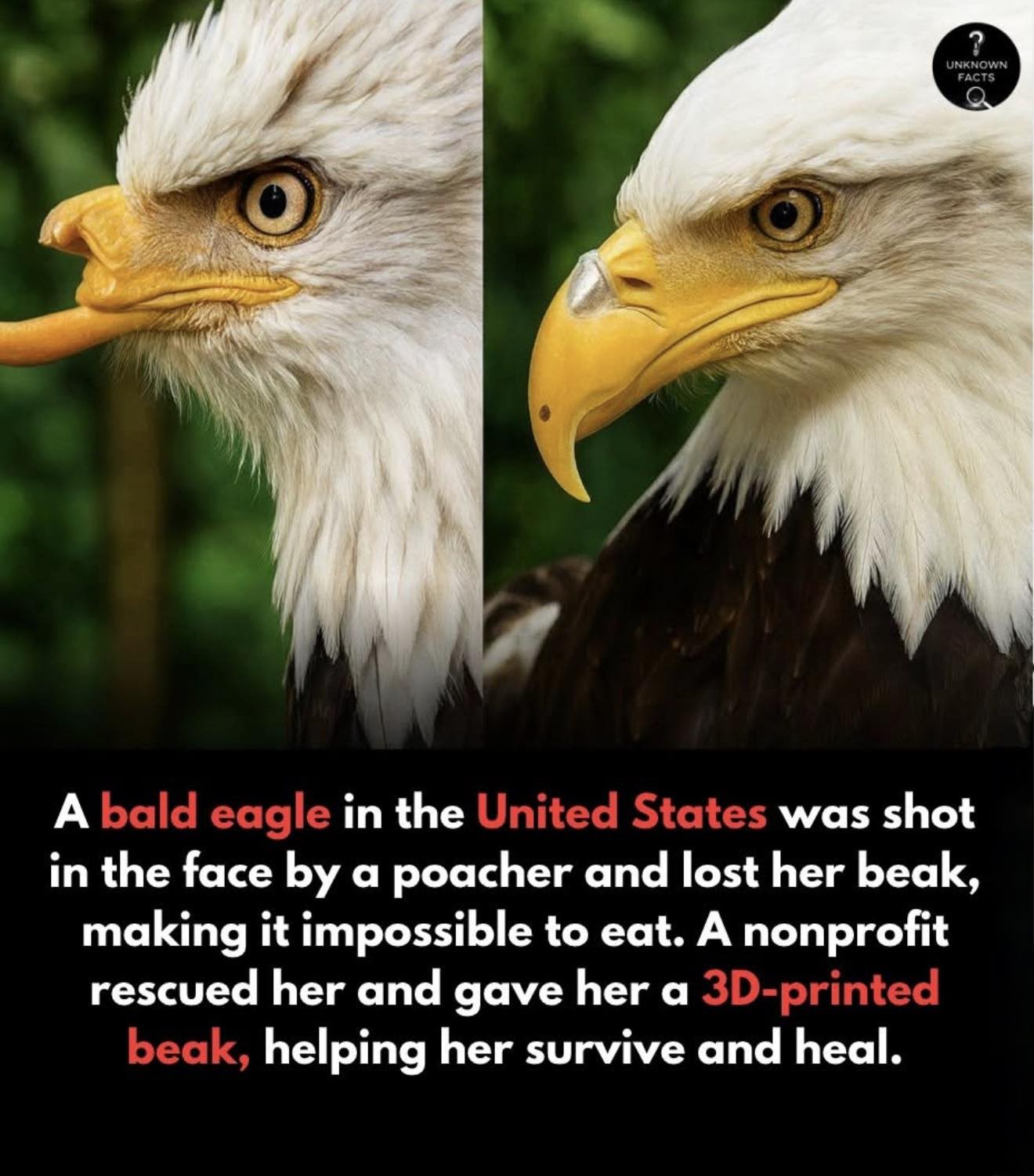In 2005, a bald eagle named Beauty was soaring freely over the skies of Alaska when her life changed in an instant. A poacher’s bullet struck her face, shattering her upper beak — one of the most vital parts of a bird’s anatomy. For most, this would have been the end. Without a beak, Beauty couldn’t eat, drink, or preen herself. She was slowly starving, unable to survive in the wild she once ruled.
But fate had other plans for her.
Rescued by a U.S.-based wildlife organization called Birds of Prey Northwest, Beauty’s heartbreaking story would soon become a global symbol of resilience and innovation. The team at the center didn’t just want to save her life — they wanted to restore her dignity. What happened next would change not only Beauty’s future but also the way humans think about saving animals through technology.
A Desperate Fight for Survival
When Beauty arrived at Birds of Prey Northwest, her condition was dire. Half her beak was gone, exposing raw tissue. She had to be hand-fed because she couldn’t grasp or tear food. Her caretakers knew she wouldn’t make it long like this.
“She looked at us with eyes full of strength,” said one of the rescuers. “It was as if she was asking us not to give up.”
And they didn’t.
The rescue team contacted engineers, wildlife experts, and 3D designers — a collaboration that would unite compassion with cutting-edge science.
A 3D Miracle
With no ready-made solution available, engineers used 3D modeling software to design a prosthetic beak tailored specifically to Beauty’s anatomy. It was a risky and unprecedented move. Every curve, every ridge of the artificial beak had to be perfect for it to function like the real thing.
After weeks of testing, scanning, and adjusting, the prototype was finally ready. In a delicate operation, the prosthetic was attached to Beauty’s damaged beak. The moment it clicked into place marked a milestone in wildlife rehabilitation.
When Beauty took her first bite of food in months, the room filled with tears. For the first time since being shot, she could feed herself again.
“She took that piece of salmon and held it up,” one of the engineers recalled, “and it was like watching hope take flight again.”
Technology Meets Compassion
Beauty’s story became one of the first and most successful examples of 3D-printed prosthetics used in wildlife recovery. The innovation didn’t just save one bird — it opened doors to future advancements for injured animals around the world.
From turtles with artificial shells to dogs with 3D-printed legs, this breakthrough inspired a wave of scientific compassion that bridged the gap between technology and nature.
What made Beauty’s case so special wasn’t just the technology. It was the teamwork — biologists, engineers, and caretakers working side by side for one simple mission: to give a wounded creature a second chance at life.
Healing Beyond the Physical
As months passed, Beauty adapted to her new beak with remarkable grace. She learned how to preen her feathers again — a crucial act of self-care that birds rely on to stay healthy.
Even more incredible, her natural beak slowly began to regrow underneath the prosthetic. It seemed as if her body, once given a second chance, decided to heal itself.
Today, Beauty remains under the care of Birds of Prey Northwest, where she continues to educate thousands of visitors each year about the devastating effects of poaching and the possibilities of compassion-driven science.
Her story isn’t just about recovery — it’s about renewal. It’s a living reminder that the line between human innovation and nature’s resilience can create miracles.
A Lesson for Humanity
Beauty’s survival story carries a powerful message that goes far beyond wildlife rehabilitation. It reminds us that while human actions can destroy, they can also rebuild.
The bullet that nearly ended her life represents cruelty and neglect — but the 3D printer that gave her a new beak represents empathy, intelligence, and the best of what humanity can be.
Every person involved in her recovery — from the rescuers who found her to the engineers who designed her beak — played a part in rewriting her destiny. Together, they showed that technology, when guided by kindness, can heal what once seemed impossible.
The Ongoing Legacy of Beauty
Today, Beauty’s story continues to inspire millions across the world. She stands as a living ambassador for conservation, education, and the marriage of science and compassion. Her image has been featured in documentaries, educational programs, and classrooms, teaching future generations about empathy, innovation, and the fight to protect wildlife.
Her caretakers often describe her as “the bird who taught humans how to care again.” And they’re right. Beauty’s recovery wasn’t just about a bird getting a new beak — it was about a broken world learning that it could still create beauty from tragedy.
Conclusion: The Bird Who Showed the World What’s Possible
From tragedy to triumph, Beauty the bald eagle is proof that no wound is too deep, and no life too lost, when compassion and innovation come together.
Her story echoes across the world as a reminder: technology should not only serve human progress but also protect the fragile lives we share this planet with.
In the quiet wings of a bird that once couldn’t eat, we find a story that nourishes the soul — a story that teaches us that even in the face of cruelty, hope can be rebuilt, layer by layer, in the form of a 3D-printed beak and the beating heart of an eagle that refused to give up.

